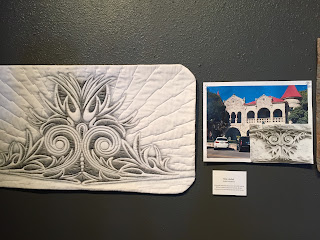It was weavers gathering day! Hurray! Always a great time to see what my fellow
weavers are doing in their studio.
Marion showed off her inkle woven bookmarks that she gave as thank you to
her garden club members.
She used natural colored cotton (green and brown) in this tape woven lenght
She also had this 'dog' off the loom after 5 years! It's is absolutely lovely!
Light and fluffy as a cloud with this mohair boucle yarn--hard to weave that's for sure,
but a real bonus for her sofa this winter.
Not all our talk is about wovens. Connie was showing off the indigo dyed
napkins, stitched in patterns. These napkins will be used for the
state conference luncheon
So many interesting and unique patterns in shibori technique
The guild is hosting stitching days where anyone can assist with these
stitchings and learn some new techniques in the process
Every napkin is different!
We'll need over 200 napkins as luncheon favors
This is my favoritef!
Connie was demonstrating how to achieve these lines in the cloth with
resist stitching
Penny showed off her woven fabrics to be used as aprons.
She used an overshot pattern between plain weave.
Look closely and you can see how the plain weave does the 'tracking' element
when washed. This has to do with the way the fibers are twisted and spun--
nice patterning technique
Penny also had these interesting towels she wove in Cottolin.
And Penny has these wonderful linen washcloths that she makes every year for the guild sale.
These sale like hotcakes--she pairs them with goat milk soap--perfect gift!
Super duper day spent with friends of like mind.












































